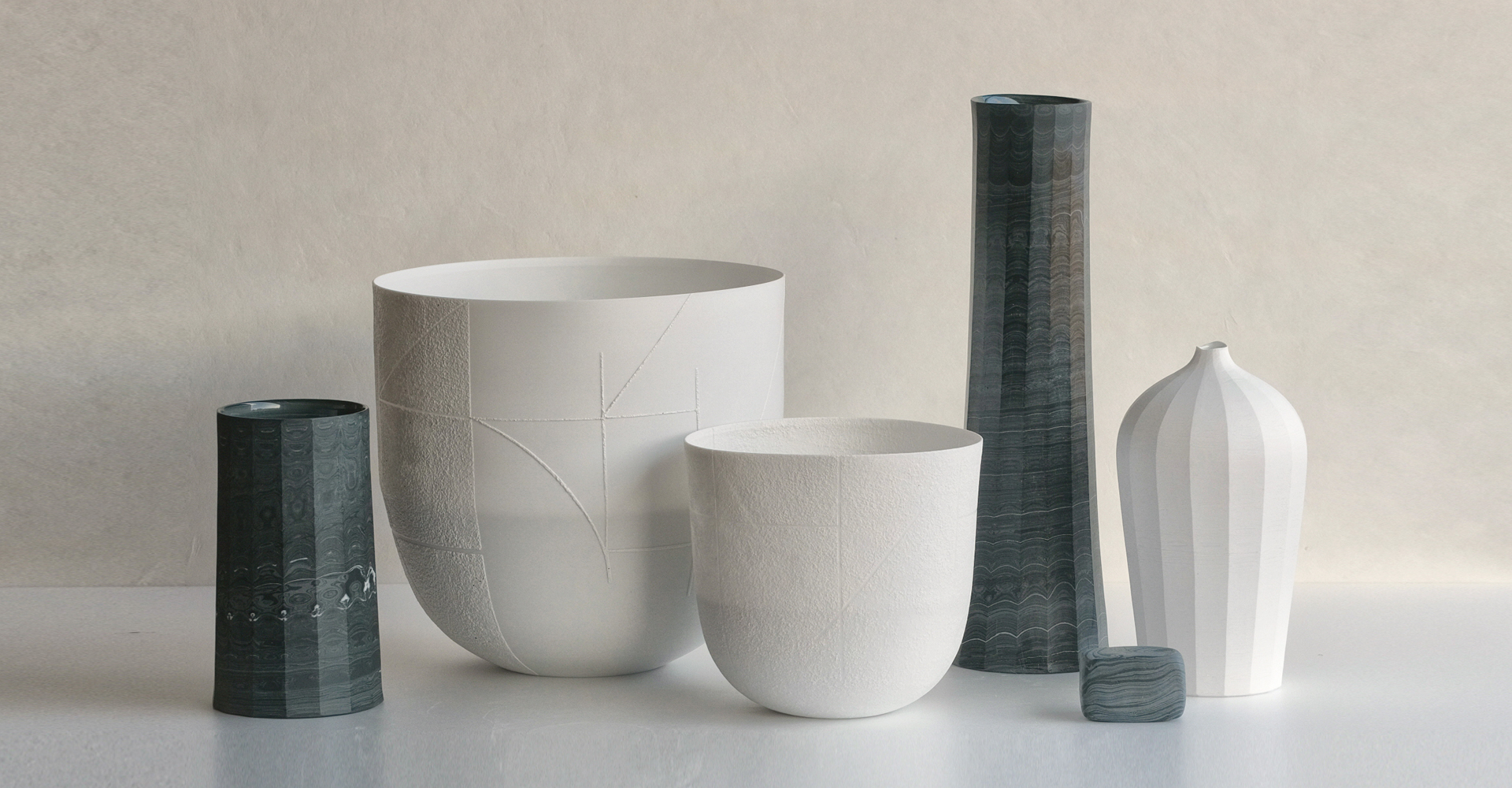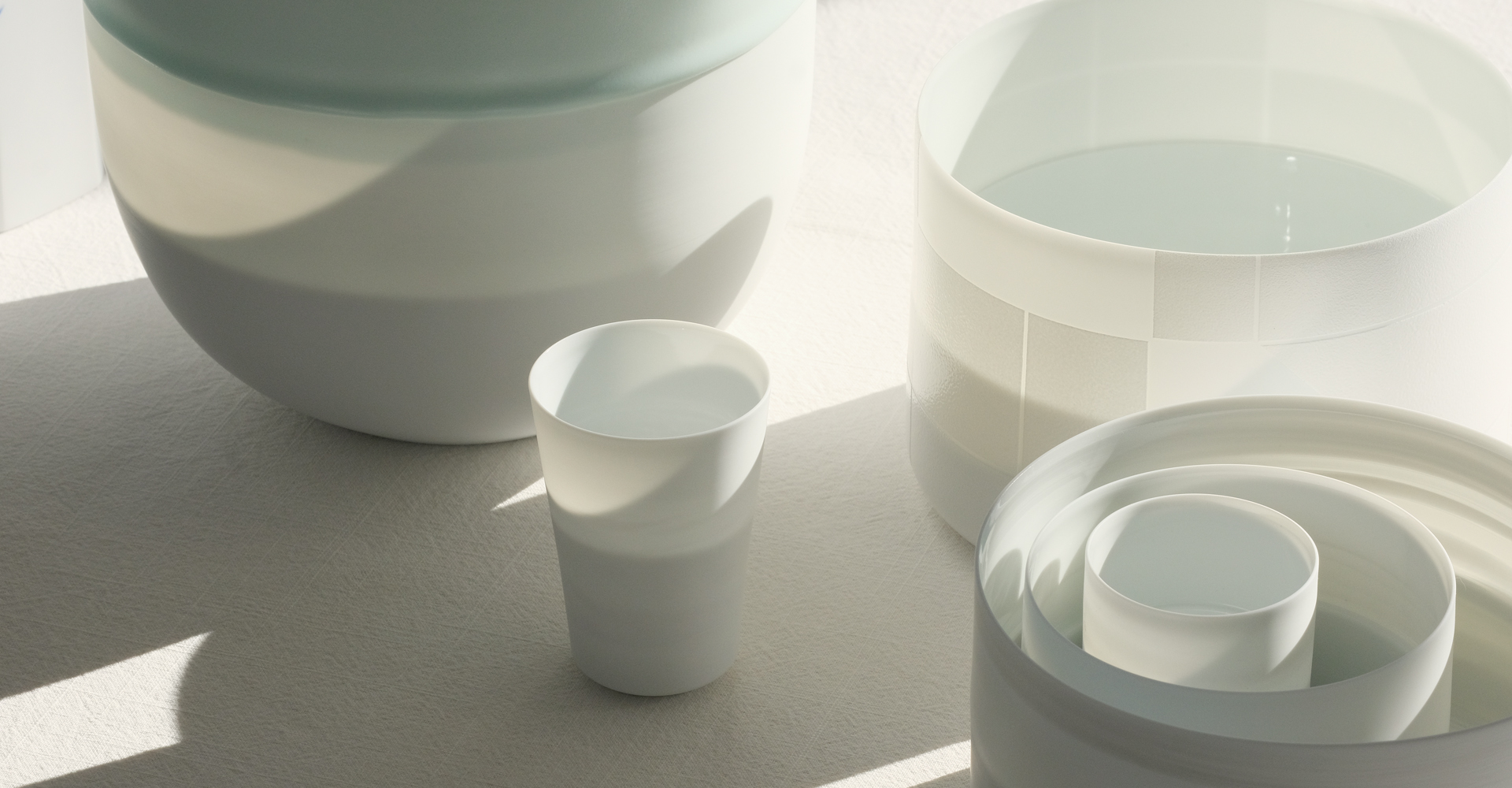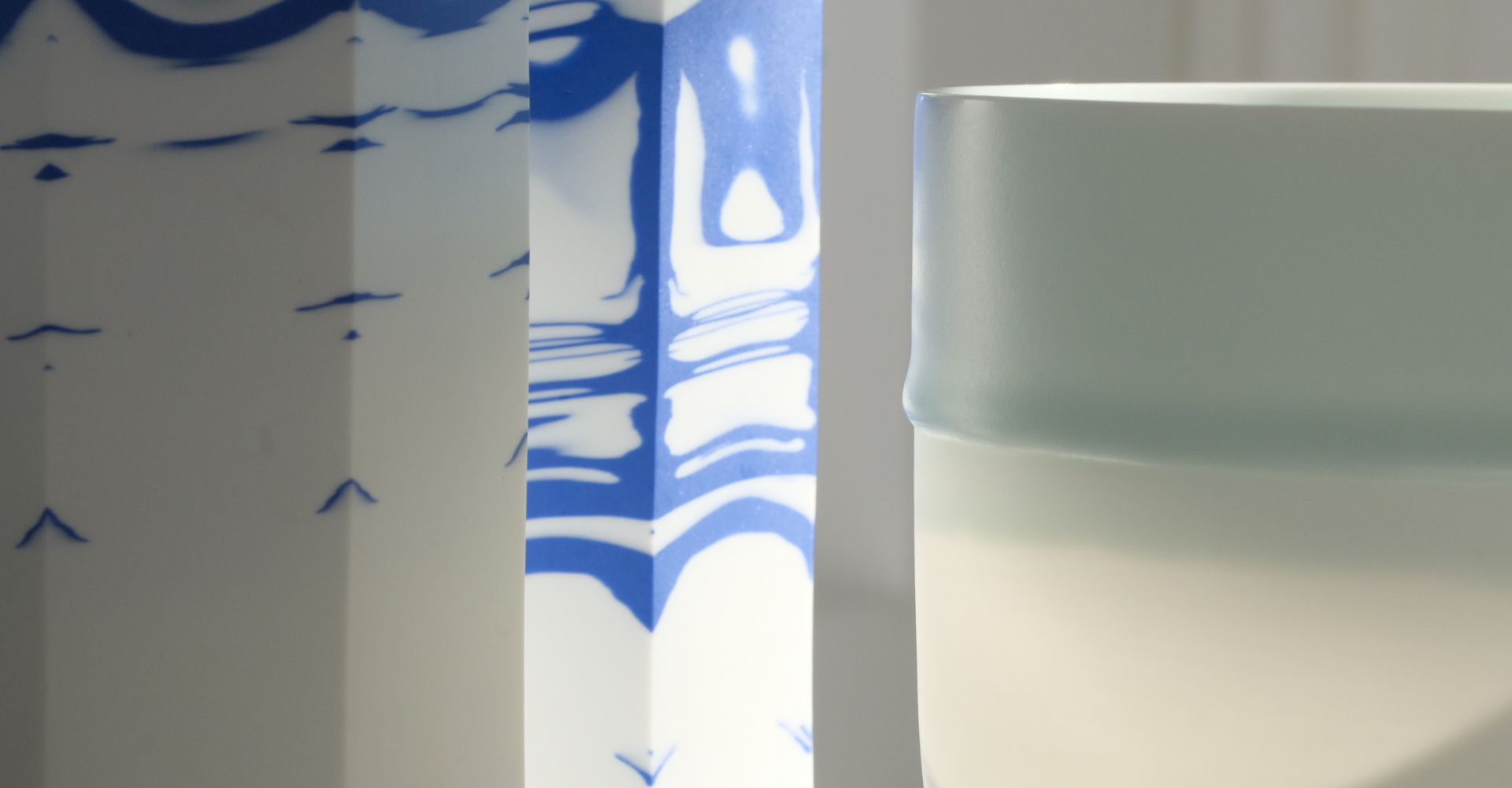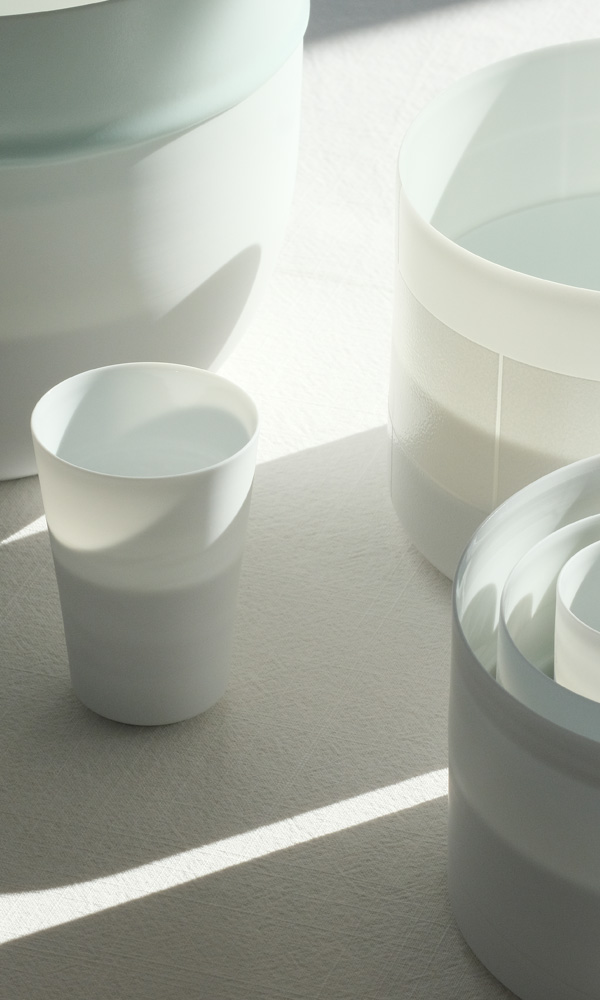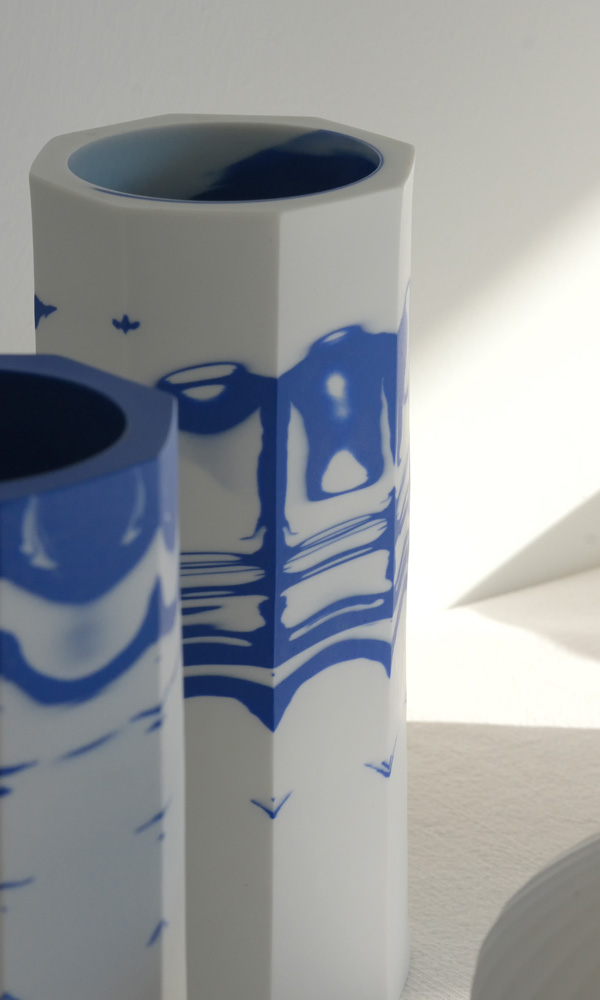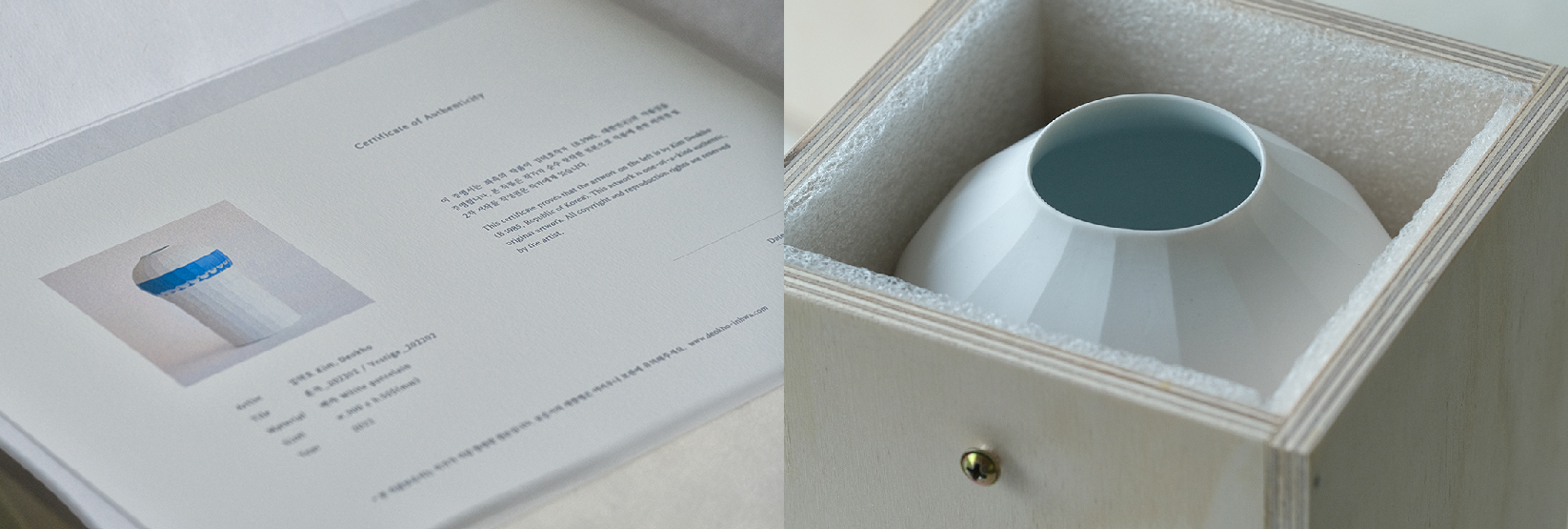
| Vestige_ CC243 |
| 구매방법 | |
|---|---|
| 배송주기 | |
Vestige_ CC243
펀딩예정
D-
펀딩종료
원
목표금액 원
%
원
년 월 배송
| 옵션선택 |
White Porcelain, 1280°C firing
TOTAL:
0 (0 Items)

Vestige_CC243 KRW 1,700,000 |
/
Vestige 흔적
겹: 시간의 겹 <재단법인예올재단 올해의 젊은 공예인 수상 전시서문 중>
2020 예올이 뽑은 올해의 젊은 공예인 도자공예가 김덕호 작가는 조선 시대 백자의 미감을 바탕으로 현대적인 도자 작품을 만들고 있다. 조선백자의 시원지인 양구에 위치한 양구백자연구소에서 백토의 물성을 연구하며 옛 시대의 수많은 유물을 통해 조선백자가 지닌 미감을 체득하였다. 이러한 경험들은 작가만의 조형 언어가 되어 군더더기 없는 정제된 형태 속에서 아름다운 선을 품은 현대 백자로 구현된다.
작가의 작품 세계를 드러내는 주요 기법인 물레 성형 기법과 연리 기법은 도자기를 만드는 아주 오래된 전통적이고 보편적인 기법이다. 두가지 기법이 만나 도자기가 만들어지는 과정을 밖으로 드러내고 손과 흙이 지나간 길을 그대로 보여준다. 차곡차곡 쌓인 흙을 한 꺼풀씩 벗겨내면 중첩된 시간의 흔적인 추상적인 겹, 연리문이 나타난다. 끊임없는 반복의 과정을 통해 드러나는 무늬들은 백자의 간결한 형태와 조화를 이루며 작가만의 독자적인 정체성을 드러내고 있다.
백자는 선조들의 일상에서 사용되는 귀하고 아름다운 사물이었고 조선의 백자는 그 안에 많은 이야기를 품고 있다. 작가는 조선백자의 역사와 문화가 살아 숨 쉬는 양구에 터를 잡고, 백자의 미감과 기능성의 조화를 끊임없이 고민하며 오늘도 물레 앞에서 수많은 시간을 보낸다. 우리 고유의 정신과 아름다움을 마음으로 되새기며 조용한 반복의 시간을 켜켜이 쌓아가고 있다.
/
올해의 젊은 공예인, 김덕호
작가는 일상에서 노동의 가치를 중시하며 ‘생각하는 손’을 통해 습득한 기술을 바탕으로 ‘백자’의 물성에 초점을 맞추어 다양한 시도를 이어가고 있다. 중국 송대에 시작된 백자(白磁)는 현대까지 이어지는 가장 대표적인 도자문화 중 하나이다. 백자 소지(白磁土)를 구성하는 주된 광물인 카올린(Kaolin, 고령토高嶺土)은 철분이 없는백색의 광물로, 일찍이 동아시아 3국의 천혜 자원이었다. 한국 또한 그중 하나로 조선시대에 이르러 고유한 백자문화가 500여 년간 지속되었다. 백자 소지(白磁土)는 1,300도를 웃도는 고온에서 자화(유리질화)되어 뛰어난 백색도와 강도그리고 투광성을 갖게 된다. 백자는 선조들의 일상에서 사용되는 귀하고 아름다운 사물이었다. 조선의 백자는 그 안에 많은 이야기를 담고 있다. 조선시대 백자토는 전국의 여러 가지 흙을 조합하여 실험을 통해 만들어진 고도의 정제된 재료였으며 그 단순미를 가진 형태는 숙련된 기술로만 완성할 수 있었다. 이러한 백자의 아름다운 물성과 간결함은 작가의 작업에 큰 영향을 미쳤다.
작가가 만드는 기器는 기본에 근본을 두고, 두 손으로 만들어 낸 것이다. 응당 갖춰야 할 실용성을갖추고 외형적으로 뺄 것은 빼고 더할 수 있는 것은 더한다. 어쩌면 더하는 것보다 빼는 것이 더어려운 선택이다. 형태적 요소가 단순해질수록더욱 신중히 모양을 결정해야 한다. 작가는 원을볼 때 무의식적으로 완벽에 가까운 원인지 생각하고, 직선을 볼 땐 어딘가 찌그러지지 않는지를확인한다. 그것이 기본이기 때문이다. 이 기본은단순함과 연결되어 있고, 단순함은 거짓 없이 그대로를 보여주는 속성이다. “형태가 단순하다고 반드시 경험의 단순함을 뜻하지 않는다.”라는 로버트 모리스의 말처럼 작가가 만든 그릇은 기본과 단순함에 기반하고 있지만 이를 손으로 성형하기 위해 물레 앞에서 보낸 수많은 시간과 흙과 마주한 두 손이 가진 반복의 경험이 녹아있다.
김덕호의 도자 공예
일상사물을 제작하는 공예가에게 재료를 잘 다루는 일은 매우 중요하다. ‘사물’을 만드는 행위는 재료에 대한 ‘이해’ 없이 불가능하기 때문이다. 재료를 이해하기 위해서는 재료와 직접 대면하여 고민하고 씨름하기를 반복해야만 한다. 이렇게 재료를 잘 다루기 위해 연습하는 과정 중에여러 가지 재미있는 물성들을 경험할 수 있다. 김덕호 작가가 다루는 백자는 크게 태토와 유약으로 나눌 수 있는데 사실 이 두 가지는 하나의연장선 위에 있으며, 작가는 항상 백토와 유약의특성과 접점을 찾기 위해 노력한다.
공예의 의미
“공예는 반복의 의미를 가장 가치있게 해주는행위이다.” 반복은 언제나 많은 시간이 필요하다. 빚어내고, 깎아내고, 갈아내는 과정이 끊임없이 이어진다. 이 과정은 눈으로 보이지 않거나알아차리기 힘들 때가 많다. 그래서 때로는 지루해 보이고 무의미해 보인다. 하지만 끊임없는 반복으로 쌓이는 경험은 공예가에게 뛰어난 손기술을 가지게 하고 높은 질의 사물을 제작하는 데큰 도움을 준다. 이러한 과정으로 만들어진 사물은 사용자에게 별다른 설명 없이도 그 가치를 느끼게 한다. 그 어느 때보다 치열하고 빠르게 흘러가는 세상에서 반복을 말하며 느리게 조금씩쌓여가는 공예적 활동은 나에게 늘 위안이 된다.
작가의 기법
작품을 완성하는데 가장 주된 방법은 물레성형과 연리기법이다. 두 기법은 도자기를 만드는 아주 오래된 전통적 기법이자 세계적으로 널리 이용되는 보편적인 기법이다. 단순하게 설명하자면 순도 높은 백토와 색토를 합쳐 빠르게 돌아가는 물레 위에서 성형한 뒤, 천천히 면을 깎아내면서 작품을 완성해 나간다. 두 가지 흙이 차곡차곡 쌓여 하나가 되는 과정을 연리라 부르며, 연리기법을 통해 백토와 색토가 합쳐져 추상적인 패턴을 가진 기器를 만든다. 물레 위에서 순간적으로 이루어지는 두 흙의 연리로 전체적인형태를 성형한다. 흙이 조금씩 말라 적절한 습도가 되면 예리한 칼로 흙을 한 꺼풀 씩 벗겨내고, 숨겨져 있던 중첩된 시간의 흔적인 추상적인 연리문이 나타난다. 연리문은 나의 의도와 성형과정에서의 우연이 조화를 이루며 독특하게 나타나고 각각의 기器에 독자적인 정체성을 부여한다. 이 흔적은 구름처럼 금방 흘러가 사라질 듯한 생동감을 가지고 있으면서도 변하지 않는 색과 강도를 가진 (자기磁器의 물성 덕분에) 단단함을 함께 가지고 있다. 이렇게 완성된 연리의흔적은 간결한 형태 속에서 아름답게 나타난다.
작업에서 중점을 두는 요소
내가 하는 일은 두 가지 흙이 일정한 규칙을 지켜조화를 이루고, 질서 안에서 자유를 누리며 추상적인 패턴이 나타나게끔 하는 것이다. 흙을 연리하여 물레 성형하는 과정, 기벽을 굽칼로 얇게 깎는 과정, 고온에서 소성한 후 외부를 연마하는 과정 등 어느 하나 단순하거나 쉬운 것이 없다. 복잡하고 어려운 과정이지만 각 과정을 소홀히 하지않는 것이 작업에서 가장 중요한 점이라 생각한다. 또한, 추상적인 색토의 흔적이 작업의 바탕이 되기 때문에 자칫 백자의 색과 형태를 헤치지않고잘 어우러지도록 노력한다.강한 색과 움직임을 가진 연리의 흔적과 형태적요소들이 어느 부분에서 단단히 받쳐주고 어느부분에서 여유 있게 풀어주어야 할지늘 고민한다. 그리고 물레 위에서의 우연적 요소가 나의의도를 가리지 않도록, 규칙안에서의 변화가 일어나도록 조심스레 흙을 합치고 신중히 물레를찬다. 지금의 패턴을 표현하기까지 많은 실험을거쳤으며 이러한 실험의 스펙트럼 안에서 가장아름다운 지점을 찾아 작업에 적용하는것 또한중요한 일이라 생각한다. 작가로서의 의도와 우연, 순간적으로 섞이는 흙과한 꺼풀 조금씩 흙을깎는 과정 어찌 보면 모순된 개념들 속에서 균형잡힌 결과를 이끌어내기 위해 노력하고 있다
Young Craftsman of the Year, Kim Deok Ho
Emphasizing the value of labor in every day life, the artist uses the techniques learned through “The Thinking Hand”as a foundation for his diverse creative endeavors, placing his focus on the physical properties of baekja (white porcelain). Originating in the Song dynasty of China, Baekja (白磁) is one of the most representative forms of ceramics still alive today. Kaolin (高嶺土), the iron-deficient white mineral mainly composing baekja soji (doughlike clay material used to make white porcelain; 白磁土), was once a precious natural resource indigenous to the “big three” East Asian nations. As one of those three, Korea has enjoyed approximately 500 years of distinctive baekja culture, beginning in the Joseon dynasty. Baekja soji undergoes vitrification at temperatures above 1,300 degrees Celsius to acquire a remarkable whiteness, durability, and translucency. Baekja were valuable and beautiful objects used in our ancestors’ everyday lives, and as such the baekja of Joseon hold within them innumerable stories. The baekja soji of the Joseon dynasty was a highly refined material produced through experimentation in mixing different kinds of clay obtained from all across the country, and the exquisite simplicity of its completed form could be attained only through expert skill. The striking attributes and stunning minimalism of baekja have had a great impact upon the artist’s work. The bowls made by the artist are ones created by his two hands, with his feet planted firmly in the basics, endowed with the necessary practicality, subtracting what should not be and adding what should. It is perhaps the subtraction and not the addition that is the harder choice. The simpler the physical elements, the more caution must be taken with the form. When the artist sees a circle, he automatically considers its degree of perfection; when he sees a straight line, he checks whether it is not crooked in some way. These are the basics. These basics are connected to simplicity, and simplicity is a quality that shows what is, exactly as it is. As Robert Morris said, “Simplicity of shape does not necessarily equate with simplicity of experience.” The bowls made by the artist are rooted in the basics and in simplicity, but contain within them the innumerable hours spent before the wheel in their shaping and the accumulated experience of two hands that have handled clay time and time again.
Kim Deok Ho’s Ceramic Craft
The skillful handling of materials is extremely important to craftsmen who produce everyday objects. This is because the act of creating an “object” is impossible without the “understanding”of one’s materials. To understand one’s materials, one must face them head on, contemplating and struggling with them over and over again. In the process of practicing the skillful handling of materials, many interesting properties can be observed. The baekja handled by craftsman Kim Deok Ho can be divided largely into taeto (ceramic clay base) and yuyak (glaze), but in truth these two are points along the same line, and the artist constantly strives to discover the characteristics and points of contact between them.
The Meaning of Craftwork
“Craftwork is the one act that grants the most value to the meaning of repetition.”Repetition always requires a great deal of time. The process of shaping, cutting away, and grinding down drags on without end. This process is often invisible or unnoticeable, and so at times seems tedious and meaningless. However, the experience accumulated through endless repetition grants craftsmen exceptional skill and immense aid in the production of high-quality objects. Objects created through this process convey the sense of their value to their users even without any particular explanation. In a world that moves fiercer and faster than ever before, the slow steady accumulation of craftwork which speaks of repetition is a source of constant solace to me.
Artist’s Techniques
The main methods I use to complete my works are wheel throwing and the yeonli technique. These two methods are very old traditional ceramic techniques as well as universal ones used all over the world. To explain in simple terms, I mix white and colored clay of high purity and shape it on a rapidly spinning wheel, then complete the work by slowly shaving away at the sides. The process wherein the two kinds of clay pile up layer by layer to become one is called yeonli, and through the yeonli technique white and colored clay join together to produce one bowl with an abstract pattern. The overall form is shaped on the wheel by the instantaneous occurrence of yeonli upon the two clays. When the clay dries bit by bit to an appropriate level of moisture, a sharp knife is used to strip o one layer at a time, revealing the abstract yeonlimun in the traces of repeated time hidden away. Yeonlimun manifests uniquely through the harmony of my intent and the chances of the shaping process to give each bowl a distinctive identity. These traces hold at once the vitality of a cloud that seems poised to float away into nothingness and, due to the physical properties of ceramics, the firmness of unchanging color and durability. So completed, the traces of yeonli present themselves with beauty in beautiful simplicity of form.
Focal Points of Creation
My task is to ensure the two clays fall into harmony according to uniform rules, and to evoke abstract patterns of freedom within order. The process of yeonli upon the clay before wheel throwing; the process of whittling down the sides with a sculpting knife; the process of firing at high temperatures and polishing the outsides: not one of these is simple or easy. It may be a complex and difficult process, but I believe the most important thing is not to neglect a single step. In addition, because the abstract traces of colored clay become the backdrop of my work, I do my best to make those traces blend in well without disturbing the color and form of the white porcelain.I constantly struggle with the questions of for which parts the formative elements and traces of yeonli with their strong colors and sense of motion should be made to provide solid support, and for which parts they should be given free rein. And so that the elements of chance upon the wheel do not obscure my intent, so that change happens within the bounds of the rules, I carefully mix the clay together and cautiously pump the wheel. Having gone through many stages of experimentation to be able to express my present patterns, I believe that finding the most beautiful point in the spectrum of your experimentation and applying it to your work is also an important task. I strive to draw balanced results from the perhaps contradictory concepts of my artistic intent and chance, the clay that mixes instantaneously and the process of whittling the clay away a little at a time.
Vestige_CC243 KRW 1,700,000 |
/
Vestige 흔적
겹: 시간의 겹 <재단법인예올재단 올해의 젊은 공예인 수상 전시서문 중>
2020 예올이 뽑은 올해의 젊은 공예인 도자공예가 김덕호 작가는 조선 시대 백자의 미감을 바탕으로 현대적인 도자 작품을 만들고 있다. 조선백자의 시원지인 양구에 위치한 양구백자연구소에서 백토의 물성을 연구하며 옛 시대의 수많은 유물을 통해 조선백자가 지닌 미감을 체득하였다. 이러한 경험들은 작가만의 조형 언어가 되어 군더더기 없는 정제된 형태 속에서 아름다운 선을 품은 현대 백자로 구현된다.
작가의 작품 세계를 드러내는 주요 기법인 물레 성형 기법과 연리 기법은 도자기를 만드는 아주 오래된 전통적이고 보편적인 기법이다. 두가지 기법이 만나 도자기가 만들어지는 과정을 밖으로 드러내고 손과 흙이 지나간 길을 그대로 보여준다. 차곡차곡 쌓인 흙을 한 꺼풀씩 벗겨내면 중첩된 시간의 흔적인 추상적인 겹, 연리문이 나타난다. 끊임없는 반복의 과정을 통해 드러나는 무늬들은 백자의 간결한 형태와 조화를 이루며 작가만의 독자적인 정체성을 드러내고 있다.
백자는 선조들의 일상에서 사용되는 귀하고 아름다운 사물이었고 조선의 백자는 그 안에 많은 이야기를 품고 있다. 작가는 조선백자의 역사와 문화가 살아 숨 쉬는 양구에 터를 잡고, 백자의 미감과 기능성의 조화를 끊임없이 고민하며 오늘도 물레 앞에서 수많은 시간을 보낸다. 우리 고유의 정신과 아름다움을 마음으로 되새기며 조용한 반복의 시간을 켜켜이 쌓아가고 있다.
/
올해의 젊은 공예인, 김덕호
작가는 일상에서 노동의 가치를 중시하며 ‘생각하는 손’을 통해 습득한 기술을 바탕으로 ‘백자’의 물성에 초점을 맞추어 다양한 시도를 이어가고 있다. 중국 송대에 시작된 백자(白磁)는 현대까지 이어지는 가장 대표적인 도자문화 중 하나이다. 백자 소지(白磁土)를 구성하는 주된 광물인 카올린(Kaolin, 고령토高嶺土)은 철분이 없는백색의 광물로, 일찍이 동아시아 3국의 천혜 자원이었다. 한국 또한 그중 하나로 조선시대에 이르러 고유한 백자문화가 500여 년간 지속되었다. 백자 소지(白磁土)는 1,300도를 웃도는 고온에서 자화(유리질화)되어 뛰어난 백색도와 강도그리고 투광성을 갖게 된다. 백자는 선조들의 일상에서 사용되는 귀하고 아름다운 사물이었다. 조선의 백자는 그 안에 많은 이야기를 담고 있다. 조선시대 백자토는 전국의 여러 가지 흙을 조합하여 실험을 통해 만들어진 고도의 정제된 재료였으며 그 단순미를 가진 형태는 숙련된 기술로만 완성할 수 있었다. 이러한 백자의 아름다운 물성과 간결함은 작가의 작업에 큰 영향을 미쳤다.
작가가 만드는 기器는 기본에 근본을 두고, 두 손으로 만들어 낸 것이다. 응당 갖춰야 할 실용성을갖추고 외형적으로 뺄 것은 빼고 더할 수 있는 것은 더한다. 어쩌면 더하는 것보다 빼는 것이 더어려운 선택이다. 형태적 요소가 단순해질수록더욱 신중히 모양을 결정해야 한다. 작가는 원을볼 때 무의식적으로 완벽에 가까운 원인지 생각하고, 직선을 볼 땐 어딘가 찌그러지지 않는지를확인한다. 그것이 기본이기 때문이다. 이 기본은단순함과 연결되어 있고, 단순함은 거짓 없이 그대로를 보여주는 속성이다. “형태가 단순하다고 반드시 경험의 단순함을 뜻하지 않는다.”라는 로버트 모리스의 말처럼 작가가 만든 그릇은 기본과 단순함에 기반하고 있지만 이를 손으로 성형하기 위해 물레 앞에서 보낸 수많은 시간과 흙과 마주한 두 손이 가진 반복의 경험이 녹아있다.
김덕호의 도자 공예
일상사물을 제작하는 공예가에게 재료를 잘 다루는 일은 매우 중요하다. ‘사물’을 만드는 행위는 재료에 대한 ‘이해’ 없이 불가능하기 때문이다. 재료를 이해하기 위해서는 재료와 직접 대면하여 고민하고 씨름하기를 반복해야만 한다. 이렇게 재료를 잘 다루기 위해 연습하는 과정 중에여러 가지 재미있는 물성들을 경험할 수 있다. 김덕호 작가가 다루는 백자는 크게 태토와 유약으로 나눌 수 있는데 사실 이 두 가지는 하나의연장선 위에 있으며, 작가는 항상 백토와 유약의특성과 접점을 찾기 위해 노력한다.
공예의 의미
“공예는 반복의 의미를 가장 가치있게 해주는행위이다.” 반복은 언제나 많은 시간이 필요하다. 빚어내고, 깎아내고, 갈아내는 과정이 끊임없이 이어진다. 이 과정은 눈으로 보이지 않거나알아차리기 힘들 때가 많다. 그래서 때로는 지루해 보이고 무의미해 보인다. 하지만 끊임없는 반복으로 쌓이는 경험은 공예가에게 뛰어난 손기술을 가지게 하고 높은 질의 사물을 제작하는 데큰 도움을 준다. 이러한 과정으로 만들어진 사물은 사용자에게 별다른 설명 없이도 그 가치를 느끼게 한다. 그 어느 때보다 치열하고 빠르게 흘러가는 세상에서 반복을 말하며 느리게 조금씩쌓여가는 공예적 활동은 나에게 늘 위안이 된다.
작가의 기법
작품을 완성하는데 가장 주된 방법은 물레성형과 연리기법이다. 두 기법은 도자기를 만드는 아주 오래된 전통적 기법이자 세계적으로 널리 이용되는 보편적인 기법이다. 단순하게 설명하자면 순도 높은 백토와 색토를 합쳐 빠르게 돌아가는 물레 위에서 성형한 뒤, 천천히 면을 깎아내면서 작품을 완성해 나간다. 두 가지 흙이 차곡차곡 쌓여 하나가 되는 과정을 연리라 부르며, 연리기법을 통해 백토와 색토가 합쳐져 추상적인 패턴을 가진 기器를 만든다. 물레 위에서 순간적으로 이루어지는 두 흙의 연리로 전체적인형태를 성형한다. 흙이 조금씩 말라 적절한 습도가 되면 예리한 칼로 흙을 한 꺼풀 씩 벗겨내고, 숨겨져 있던 중첩된 시간의 흔적인 추상적인 연리문이 나타난다. 연리문은 나의 의도와 성형과정에서의 우연이 조화를 이루며 독특하게 나타나고 각각의 기器에 독자적인 정체성을 부여한다. 이 흔적은 구름처럼 금방 흘러가 사라질 듯한 생동감을 가지고 있으면서도 변하지 않는 색과 강도를 가진 (자기磁器의 물성 덕분에) 단단함을 함께 가지고 있다. 이렇게 완성된 연리의흔적은 간결한 형태 속에서 아름답게 나타난다.
작업에서 중점을 두는 요소
내가 하는 일은 두 가지 흙이 일정한 규칙을 지켜조화를 이루고, 질서 안에서 자유를 누리며 추상적인 패턴이 나타나게끔 하는 것이다. 흙을 연리하여 물레 성형하는 과정, 기벽을 굽칼로 얇게 깎는 과정, 고온에서 소성한 후 외부를 연마하는 과정 등 어느 하나 단순하거나 쉬운 것이 없다. 복잡하고 어려운 과정이지만 각 과정을 소홀히 하지않는 것이 작업에서 가장 중요한 점이라 생각한다. 또한, 추상적인 색토의 흔적이 작업의 바탕이 되기 때문에 자칫 백자의 색과 형태를 헤치지않고잘 어우러지도록 노력한다.강한 색과 움직임을 가진 연리의 흔적과 형태적요소들이 어느 부분에서 단단히 받쳐주고 어느부분에서 여유 있게 풀어주어야 할지늘 고민한다. 그리고 물레 위에서의 우연적 요소가 나의의도를 가리지 않도록, 규칙안에서의 변화가 일어나도록 조심스레 흙을 합치고 신중히 물레를찬다. 지금의 패턴을 표현하기까지 많은 실험을거쳤으며 이러한 실험의 스펙트럼 안에서 가장아름다운 지점을 찾아 작업에 적용하는것 또한중요한 일이라 생각한다. 작가로서의 의도와 우연, 순간적으로 섞이는 흙과한 꺼풀 조금씩 흙을깎는 과정 어찌 보면 모순된 개념들 속에서 균형잡힌 결과를 이끌어내기 위해 노력하고 있다
Young Craftsman of the Year, Kim Deok Ho
Emphasizing the value of labor in every day life, the artist uses the techniques learned through “The Thinking Hand”as a foundation for his diverse creative endeavors, placing his focus on the physical properties of baekja (white porcelain). Originating in the Song dynasty of China, Baekja (白磁) is one of the most representative forms of ceramics still alive today. Kaolin (高嶺土), the iron-deficient white mineral mainly composing baekja soji (doughlike clay material used to make white porcelain; 白磁土), was once a precious natural resource indigenous to the “big three” East Asian nations. As one of those three, Korea has enjoyed approximately 500 years of distinctive baekja culture, beginning in the Joseon dynasty. Baekja soji undergoes vitrification at temperatures above 1,300 degrees Celsius to acquire a remarkable whiteness, durability, and translucency. Baekja were valuable and beautiful objects used in our ancestors’ everyday lives, and as such the baekja of Joseon hold within them innumerable stories. The baekja soji of the Joseon dynasty was a highly refined material produced through experimentation in mixing different kinds of clay obtained from all across the country, and the exquisite simplicity of its completed form could be attained only through expert skill. The striking attributes and stunning minimalism of baekja have had a great impact upon the artist’s work. The bowls made by the artist are ones created by his two hands, with his feet planted firmly in the basics, endowed with the necessary practicality, subtracting what should not be and adding what should. It is perhaps the subtraction and not the addition that is the harder choice. The simpler the physical elements, the more caution must be taken with the form. When the artist sees a circle, he automatically considers its degree of perfection; when he sees a straight line, he checks whether it is not crooked in some way. These are the basics. These basics are connected to simplicity, and simplicity is a quality that shows what is, exactly as it is. As Robert Morris said, “Simplicity of shape does not necessarily equate with simplicity of experience.” The bowls made by the artist are rooted in the basics and in simplicity, but contain within them the innumerable hours spent before the wheel in their shaping and the accumulated experience of two hands that have handled clay time and time again.
Kim Deok Ho’s Ceramic Craft
The skillful handling of materials is extremely important to craftsmen who produce everyday objects. This is because the act of creating an “object” is impossible without the “understanding”of one’s materials. To understand one’s materials, one must face them head on, contemplating and struggling with them over and over again. In the process of practicing the skillful handling of materials, many interesting properties can be observed. The baekja handled by craftsman Kim Deok Ho can be divided largely into taeto (ceramic clay base) and yuyak (glaze), but in truth these two are points along the same line, and the artist constantly strives to discover the characteristics and points of contact between them.
The Meaning of Craftwork
“Craftwork is the one act that grants the most value to the meaning of repetition.”Repetition always requires a great deal of time. The process of shaping, cutting away, and grinding down drags on without end. This process is often invisible or unnoticeable, and so at times seems tedious and meaningless. However, the experience accumulated through endless repetition grants craftsmen exceptional skill and immense aid in the production of high-quality objects. Objects created through this process convey the sense of their value to their users even without any particular explanation. In a world that moves fiercer and faster than ever before, the slow steady accumulation of craftwork which speaks of repetition is a source of constant solace to me.
Artist’s Techniques
The main methods I use to complete my works are wheel throwing and the yeonli technique. These two methods are very old traditional ceramic techniques as well as universal ones used all over the world. To explain in simple terms, I mix white and colored clay of high purity and shape it on a rapidly spinning wheel, then complete the work by slowly shaving away at the sides. The process wherein the two kinds of clay pile up layer by layer to become one is called yeonli, and through the yeonli technique white and colored clay join together to produce one bowl with an abstract pattern. The overall form is shaped on the wheel by the instantaneous occurrence of yeonli upon the two clays. When the clay dries bit by bit to an appropriate level of moisture, a sharp knife is used to strip o one layer at a time, revealing the abstract yeonlimun in the traces of repeated time hidden away. Yeonlimun manifests uniquely through the harmony of my intent and the chances of the shaping process to give each bowl a distinctive identity. These traces hold at once the vitality of a cloud that seems poised to float away into nothingness and, due to the physical properties of ceramics, the firmness of unchanging color and durability. So completed, the traces of yeonli present themselves with beauty in beautiful simplicity of form.
Focal Points of Creation
My task is to ensure the two clays fall into harmony according to uniform rules, and to evoke abstract patterns of freedom within order. The process of yeonli upon the clay before wheel throwing; the process of whittling down the sides with a sculpting knife; the process of firing at high temperatures and polishing the outsides: not one of these is simple or easy. It may be a complex and difficult process, but I believe the most important thing is not to neglect a single step. In addition, because the abstract traces of colored clay become the backdrop of my work, I do my best to make those traces blend in well without disturbing the color and form of the white porcelain.I constantly struggle with the questions of for which parts the formative elements and traces of yeonli with their strong colors and sense of motion should be made to provide solid support, and for which parts they should be given free rein. And so that the elements of chance upon the wheel do not obscure my intent, so that change happens within the bounds of the rules, I carefully mix the clay together and cautiously pump the wheel. Having gone through many stages of experimentation to be able to express my present patterns, I believe that finding the most beautiful point in the spectrum of your experimentation and applying it to your work is also an important task. I strive to draw balanced results from the perhaps contradictory concepts of my artistic intent and chance, the clay that mixes instantaneously and the process of whittling the clay away a little at a time.

